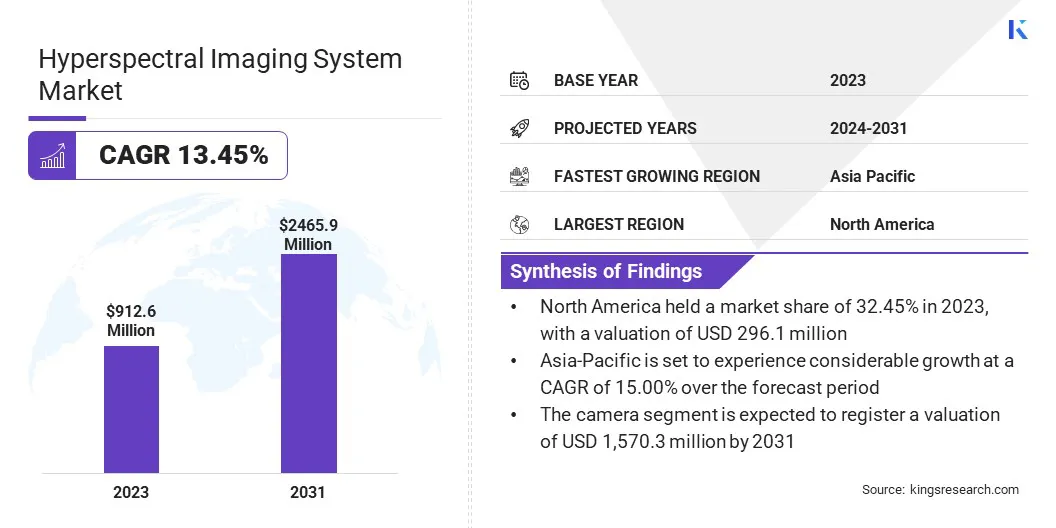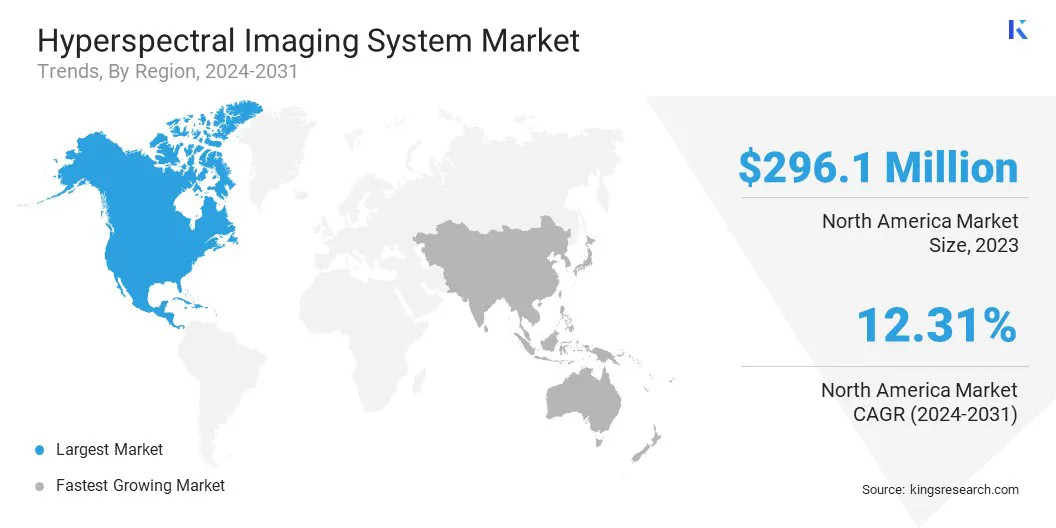Hyperspectral Imaging System Market Size
Global Hyperspectral Imaging System Market size was recorded at USD 912.6 million in 2023, which is estimated to be at USD 1,019.4 million in 2024 and projected to reach USD 2,465.9 million by 2031, growing at a CAGR of 13.45% from 2024 to 2031.
The hyperspectral imaging market is experiencing significant growth, driven by technological advancements and increasing adoption across diverse industries. Key players are focused on advancing sensor technology, improving spectral resolution, and enhancing data processing capabilities to meet the evolving demands of diverse sectors such as agriculture, healthcare, defense, and environmental monitoring.
In the scope of work, the report includes solutions offered by companies such as Galileo Group, Inc., BaySpec Inc, Specim Spectral Imaging Ltd, Corning Incorporated, Headwall Photonics Inc., Resonon Inc., HyperMed Imaging Inc., Norsk Elektro Optikk AS, Cubert GmbH., XIMEA GmbH and others.
The hyperspectral imaging market is experiencing steady growth due to increasing applications across various industries such as agriculture, healthcare, defense, environmental monitoring, and research and development.
Hyperspectral imaging technology allows for detailed analysis and visualization of materials based on their spectral signatures, enabling precise identification of objects, substances, and conditions that are not easily detectable with conventional imaging techniques. In agriculture, hyperspectral imaging aids in crop health monitoring, disease detection, and yield optimization.
In healthcare, it facilitates non-invasive diagnostics, tissue analysis, and disease identification. Additionally, advancements in sensor technology, miniaturization, and data analytics are fostering market growth, making hyperspectral imaging more accessible and cost-effective for a broader range of applications. The market is characterized by ongoing research and development efforts aimed at enhancing imaging capabilities, improving data processing efficiency, and expanding commercial opportunities across industries.
Hyperspectral imaging is an advanced and non-invasive imaging technique that combines spectroscopy and traditional imaging to capture and analyze detailed spectral information across a broad range of wavelengths. Unlike conventional imaging systems that capture images in only a few spectral bands (such as red, green, and blue), hyperspectral imaging records data in hundreds of narrow, contiguous spectral bands.
Key components of the hyperspectral imaging system include hyperspectral sensors, optics, cameras, software for data acquisition and analysis, and specialized hardware for data processing. The market encompasses a range of applications such as target detection and reconnaissance in defense and security, mineral exploration and resource mapping in mining, and environmental assessment and monitoring.

Analyst’s Review
The hyperspectral imaging system market is witnessing substantial growth, largely fueled by technological innovations and strategic efforts by key players to enhance market expansion.
Leading companies in this sector are supporting this growth through continuous research and development, with a major focus on improving sensor technology, spectral resolution, and data processing capabilities. These advancements are crucial in meeting the evolving demands of industries such as agriculture, healthcare, defense, and environmental monitoring, thereby expanding the scope of hyperspectral imaging applications.
Moreover, major players are enhancing their product portfolios to offer comprehensive solutions encompassing integrated systems, software platforms, and customized applications. This focus on product innovation and usability is leading to widespread adoption and increased customer satisfaction.
Hyperspectral Imaging System Market Growth Factors
The expansion of the market is facilitated by the rising adoption of hyperspectral imagery systems across multiple sectors including R&D, healthcare, defense, food industry, night vision, and remote sensing, fueled by the technology's versatile applications and unique capabilities.
For instance, in research and development, hyperspectral imaging enables precise material analysis and scientific exploration. In healthcare, it serves as a non-invasive diagnostic tool for detecting diseases and assessing tissue health.
Additionally, the technology plays a vital role in ensuring food safety, improving night vision capabilities, and providing valuable environmental insights through remote sensing. The increasing utilization of hyperspectral imaging across diverse sectors underscore its potential to drive innovation, efficiency, and informed decision-making, thus propelling market growth.
However, despite the numerous advantages offered by hyperspectral imaging systems, several challenges hinder their widespread adoption. The rising cost is expected to significantly hinder market progress, as these systems often require specialized hardware and software components, resulting in substantial investment and operational expenses.
Moreover, the complexity of hyperspectral data necessitates skilled personnel proficient in data acquisition, processing, and interpretation, adding to the operational complexity and resource requirements. To overcome these challenges, market participants are focusing on several factors such as advancements in technology, simplified workflows, user-friendly software interfaces, and comprehensive training initiatives to foster broader adoption of hyperspectral imaging across diverse industries.
Hyperspectral Imaging System Market Trends
The market is witnessing a notable trend of hyperspectral imaging being utilized as a diagnostic tool. The adoption of hyperspectral imaging (HSI) as a diagnostic tool in medical applications is further propelled by its non-invasive, hygienic, and efficient nature.
HSI offers significant potential in revolutionizing medical diagnostics by enabling non-contact measurements that provide reliable insights into tissue health and physiological processes. This trend is fueled by the ability of hyperspectral cameras to conduct non-contact skin measurements, offering valuable information on tissue characteristics such as oxygenation levels and blood circulation efficiency. This capability is particularly beneficial in diagnosing conditions such as open wounds and burn wounds, where precise assessment of tissue health is crucial for effective treatment planning.
Moreover, hyperspectral imaging is utilized in identifying cancer tumors and detecting blood circulation abnormalities associated with conditions such as diabetes. Ongoing technological advancements due to the utilization of machine learning and artificial intelligence (AI) to enhance the capabilities of imaging systems for automated analysis and interpretation of spectral data are expected to fuel market growth.
This trend showcases a major shift toward more sophisticated and smart imaging solutions capable of processing large datasets efficiently. By leveraging machine learning algorithms, hyperspectral imaging systems are able to automate tasks such as material identification, object detection, and disease diagnosis based on spectral signatures.
In healthcare, the utilization of AI-driven hyperspectral imaging facilitates precise and automated diagnostic processes, thereby improving patient outcomes and streamlining medical workflows. Defense and surveillance applications gain advantages from automated target detection and classification, enhancing situational awareness and operational effectiveness.
The trend of integrating machine learning and AI into hyperspectral imaging systems is improving data analysis capabilities and creating new possibilities for innovative applications across industries such as environmental monitoring, mining, and industrial quality control. This trend underscores the growing demand for advanced imaging, thereby contributing to the expansion of the hyperspectral imaging market.
Segmentation Analysis
The global hyperspectral imaging system market is segmented based on application, product type, and region.
By Application
Based on application, the market is segmented into remote sensing, machine vision, research and diagnostics, monitoring & surveillance, and other. The monitoring & surveillance segment led the market in 2023, reaching a valuation of USD 315.4 million.
The monitoring and surveillance segment within the hyperspectral imaging system market is witnessing substantial growth and increased adoption across a wide range of industries. For instance, in defense and security applications, hyperspectral imaging systems play a vital role in target detection, reconnaissance, and intelligence gathering by identifying concealed objects and potential threats with detailed spectral analysis.
Additionally, in environmental monitoring, hyperspectral imaging enables precise assessments of vegetation health, water quality, and land use, thereby supporting forestry management and ecosystem analysis. The technology extend to remote sensing and geographic information systems (GIS), where hyperspectral data aids in mapping land cover types and geological features for urban planning and disaster response.
As technological advancements continue to improve accessibility and usability, the monitoring and surveillance segment is poised to observe sustained growth and innovation across diverse industries requiring advanced imaging solutions for enhanced detection and analysis capabilities.
By Product Type
Based on product type, the market is bifurcated into camera and accessories. The camera segment is expected to register a valuation of USD 1,570.3 million in by 2031. This growth is fueled by notable technological advancements, including high-speed and cost-effective circuits, advanced manufacturing techniques, and innovative signal-processing methods in sensor development.
Factors such as product quality, economic efficiency, and technical reliability are anticipated to stimulate the growth of the segment. A hyperspectral camera captures light intensity across a broad range of spectral bands, providing each pixel in the image with a continuous spectrum. This capability enables precise and detailed object identification.
Additionally, the increasing availability of affordable cameras and expanding computing capabilities are expected to increase the adoption of hyperspectral imaging products, contributing significantly to segmental growth.
Hyperspectral Imaging System Market Regional Analysis
Based on region, the global hyperspectral imaging system market is classified into North America, Europe, Asia-Pacific, MEA, and Latin America.

The North America Hyperspectral Imaging System Market share stood around 32.45% in 2023 in the global market, with a valuation of USD 296.1 million. This notable growth is largely attributed to the region's advanced technological infrastructure, substantial investments in research and development, and the presence of key market players. The region is experiencing widespread adoption of hyperspectral imaging technology across diverse industries such as healthcare, agriculture, defense, and environmental monitoring.
Additionally, favourable government initiatives and collaborations between industry stakeholders and research institutes have played a pivotal role in bolstering regional market growth. These initiatives are expected to foster innovation, support technological advancements, and facilitate the integration of hyperspectral imaging solutions into various sectors, further strengthening the region's dominance in the global hyperspectral imaging market.
Asia-Pacific is set to experience considerable growth at a CAGR of 15.00% over the forecast period, mainly due to several key factors, including rapid industrialization, technological advancements, and increased investments in research and development.
Countries such as China, Japan, and India are at the forefront of adopting hyperspectral imaging technology across diverse sectors such as agriculture, healthcare, and mining. The region's large population, expanding healthcare infrastructure, and growing demand for high-quality agricultural products contribute significantly to the Asia-Pacific hyperspectral imaging system market.
Competitive Landscape
The global hyperspectral imaging system market report will provide valuable insight with an emphasis on the fragmented nature of the industry. Prominent players are focusing on several key business strategies such as partnerships, mergers and acquisitions, product innovations, and joint ventures to expand their product portfolio and increase their market shares across different regions.
Strategic initiatives, including investments in R&D activities, the establishment of new manufacturing facilities, and supply chain optimization, could create new opportunities for market growth.
List of Key Companies in Hyperspectral Imaging System Market
- Galileo Group, Inc.
- BaySpec, Inc.
- Specim Spectral Imaging Ltd
- Corning Incorporated
- Surface Optics Corporation
- Resonon Inc.,
- HyperMed Imaging, Inc.
- Norsk Elektro Optikk
- Cubert GmbH
- XIMEA GmbH
Key Industry Developments
- January 2024 (Collaboration): Spectral Imaging Ltd. and GEONA hyperspectral collaborated to support GEONA as the preferred standalone processing option for the entire range of SPECIM airborne hyperspectral sensors. With this agreement, Specim acknowledged GEONA's proficiency in handling and interpreting hyperspectral data obtained from SPECIM's aerial sensors.
- April 2023, (Partnership): Headwall Photonics and K8 partnered with Aermatica3D, designating them as an authorized and official reseller of their remote sensing products in Italy. Aermatica3D's engineering expertise enables the development of custom solutions tailored for companies, professional firms, and research institutes. They leverage their capabilities to enhance the distribution and customization of Headwall Photonics and K8's remote sensing offerings within the Italian market.
The Global Hyperspectral Imaging System Market is Segmented as:
By Application
- Remote Sensing
- Machine Vision
- Research and Diagnostics
- Monitoring & Surveillance
- Other Application
By Product Type
By Region
- North America
- Europe
- France
- U.K.
- Spain
- Germany
- Italy
- Russia
- Rest of Europe
- Asia-Pacific
- China
- Japan
- India
- South Korea
- Rest of Asia-Pacific
- Middle East & Africa
- GCC
- North Africa
- South Africa
- Rest of Middle East & Africa
- Latin America
- Brazil
- Argentina
- Rest of Latin America


